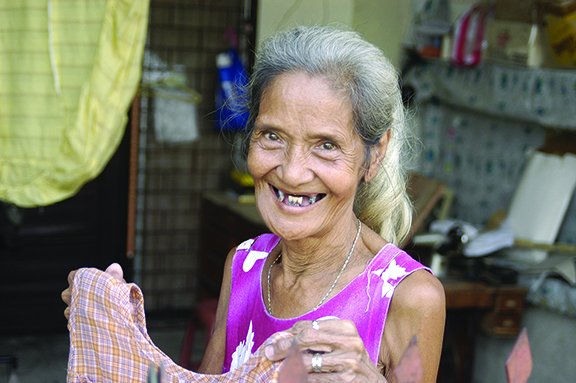Photographer recalls visit to the Philippines
by Jill Ragar Esfeld
jill.esfeld@theleaven.org
When Leaven Photographer Elaina Cochran heard about the devastation wrought by Typhoon Haiyan in the Philippines, the first thing she thought of was a bracelet wrapped around the base of a candle on her prayer table.
In February 2005, Cochran went to the Philippines to document a mission trip with the Christian Foundation for Children and Aging.
When she returned, she said, “I was completely unprepared for how emotional a trip it was.
“Though these people are living in very poor conditions, they’re still completely thankful for what they have.
“Every day, I was just overwhelmed with their gratitude and the beauty of the culture.”
The memories Cochran recorded in her heart have been as enduring as the moments she captured with her camera.
In the wake of the recent devastation, she took a moment to reflect on her experience in the Philippines, her concern for its people — and that bracelet.
“I met these three girls when I was there,” she recalled. “They were just so sweet and beautiful. They gave me the bracelet of beads because they wanted to make sure I remembered.
“They hardly had anything, but they gave me a gift.”
Cochran said she looks at the bracelet every day.
“And I think of those girls,” she said. “But more so now, and it’s such a widespread devastation, that my heart just goes out to all of the people of the Philippines.”
It’s estimated that four million people lived within 30 miles of the direct path of Haiyan, and that the storm was 3.5 times stronger than Hurricane Katrina in New Orleans.
Cochran has a hard time envisioning that kind of destruction in an area where life is already so hard.
“The living conditions are just unbelievable,” she said. “You can’t visualize it until you see it, and there is just no way of describing it.
“I remember being very thankful I was a photographer, just so I could say, ‘Here, look.’”
Cochran particularly recalled a visit to what she called a squatter’s community.
“It really reminded me of a kind of a ramshackle, urban version of ‘Swiss Family Robinson,’” she said. “It was just all these homes that were constructed essentially of tin sheets and scrap wood with maybe some bamboo.
“They almost resembled chicken coops, you know, in the [American] South, with a lot of old tires thrown on the top of the roofs to hold the tin down.”
When, at the height of the storm, television coverage showed high winds tearing roofs off homes as waves came crashing into them, Cochran couldn’t stop thinking about those fragile tin-and-wood structures.
“Things seemed so precariously built with whatever was available,” she said. “We would go through these alleys that were very narrow and lined with two- and three-story shanties, basically.
“It’s really been on my mind — the fact that they couldn’t possibly withstand a typhoon.”
She also thought about the many families that would be displaced by the storm. Most of the homes she visited sheltered multiple generations.
“What keeps presenting itself in my mind is the vision of this lack of space,” she said. “Basically, they’re living in what almost seems like a landfill — once things start to fall, that has to be horrible.”
Cochran said that surviving a normal day in the Philippines is a challenge in itself because of the grinding poverty, the extreme heat and humidity, and the poor, crowded housing conditions.
“And then you add a natural disaster,” she said. “It just hurts my heart for them.”
Cochran remembered one village where she watched children play near a stream that was polluted with trash and sewage.
“The streams were basically like sewers,” she said. “And then when that mixes in with the water that comes in from the storm — I just feel disease is going to be a challenge, too.”
Cochran remembers more than the difficult living conditions — she remembers the beautiful spirit of the Filipino people that seemed to lift them above their difficult circumstances.
“It’s a dichotomy,” she said. “The physical environment presents such hardship, but their spirits are beautiful, they’re physically beautiful, and they are just so caring and warm that it completely eradicates what’s happening around them.”
She hopes that spirit can endure and get them through this overwhelming tragedy.
“I think people band together in times of strife,” she said, “and they are already very resilient.”
Cochran believes that resilient spirit comes, in part, from their simple lives that naturally center on family and friends.
“Their priorities are different from ours,” she explained. “If you’re just trying to survive, then you’re going to put your appreciation and focus on what you have, which is your family and friends.
“And so I think that gives them a very beautiful outlook on life, even when they have challenging living conditions.”
Since her visit to the Philippines almost 10 years ago, much has happened in Cochran’s own life — she’s married now and has children of her own.
These life experiences make her feel even more connected to the families she met in the Philippines.
“Life experience in general assists your empathy because you can put yourself in that situation,” she said. “I can’t imagine existing with my family the way they do on a normal day — much less adding this tragedy on top of it.”
But Cochran was heartened by her memory of the Catholic Church in the Philippines, and she believes it will function as an important support system for the people.
“From what I saw,” she said, “it was very communal, and people helped each other.
“There was a level of accountability in the parishes, and that makes sense as a natural way of allocating resources and just being able to account for people more quickly.
“That network in place will be a good resource.”
Cochran expressed her hope that people here will give generously to help the Filipinos in their recovery.
“It’s really heartbreaking to see them have to experience this,” she said. “They are really just a very beautiful, loving people.
“They really do deserve any attention and resources anyone is willing to give.”
The Catholic Church in the Philippines
Though life is often difficult in the Philippines, the spirits of its people are lifted by their shared faith.
It’s estimated that more than 80 percent of the population is Roman Catholic. And natives will tell you there always seems to be a Catholic festival going on somewhere in the Philippines.
That’s because every town holds at least one “fiesta” each year devoted to the feast day of its patron saint to petition for good health and a good harvest.
These celebrations are always filled with music, food, and dancing — and they’re always flavored with the Spanish tradition and heritage that brought the Catholic faith to the region.
Roman Catholicism first came to the Philippines when Magellan landed in 1521. The Spanish built settlements there and, in the 1560s, Spanish political rule was established.
The country was named after the Spanish king Philip II and, although Spanish rule ended after a revolt in 1896, the Catholic faith continued to spread.
Religious orders from Spain, especially the Dominicans, Franciscans and Augustinians, evangelized much of the country while establishing churches, schools and universities.
Today, Catholic values and traditions permeate Filipino culture, and the Spanish influence can be seen in religious celebrations, as well as the architecture of the many old Spanish colonial churches.
The region boasts the third largest number of Catholic citizens in the world after Brazil and Mexico, and, aside from East Timor, it is the only predominantly Catholic nation in Asia.
According to a recent article in the Philippine Daily Inquirer, last year the number of Filipino Catholics reached 76.18 million out of the country’s estimated population of 96.8 million.
The Catholic Church in the Philippines stands organized and ready to help its people recover from the tragedy of Typhoon Haiyan.
Immediately following the disaster, the country’s bishops called for prayers and began working with the local governments, Caritas partners and local parishes to maximize response and recovery efforts.
Catholic Relief Services is on the ground supplying support and aid and is accepting donations through its website.
Last Sunday, during the Angelus from his window over St. Peter’s Square, Pope Francis led prayers for those affected by the typhoon.
“I wish to express my closeness to the people of the Philippines and that region that has been hit by a terrible typhoon,” he said. “Unfortunately, the victims are many and the damage is enormous.”







